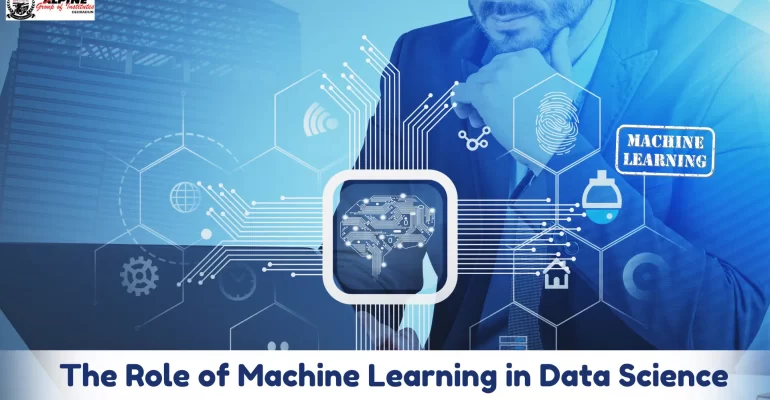The Role of Machine Learning in Data Science
2025-03-11 4:24The Role of Machine Learning in Data Science
Machine learning (ML) has become the backbone of modern data science. From automating complex processes to uncovering hidden patterns in vast amounts of data, ML has revolutionized industries ranging from healthcare to finance, marketing, and beyond.BTech in Computer Science Engineering (CSE) provides the perfect foundation to dive deep into this transformative field. Whether you’re a student or a professional looking to understand how ML is reshaping data science, this article will provide you with key insights.
1. Understanding Machine Learning and Data Science
Machine Learning (ML) is a subset of Artificial Intelligence (AI) that enables systems to learn from data without being explicitly programmed. It involves the development of algorithms that allow machines to improve their performance over time by recognizing patterns in large datasets.
Data Science, on the other hand, is the field of study that uses scientific methods, processes, algorithms, and systems to extract knowledge and insights from structured and unstructured data. It involves a mix of statistics, data analysis, and machine learning to derive actionable insights.
Together, Machine Learning and Data Science work hand-in-hand to unlock the full potential of data. ML algorithms allow data scientists to create predictive models, identify trends, and make data-driven decisions across various sectors.
2. The Role of Machine Learning in Data Science
a) Automating Complex Data Analysis
One of the main contributions of ML to data science is its ability to automate data analysis processes. Traditionally, data analysis required extensive manual effort to identify patterns, correlations, and trends. However, with ML, algorithms can automate the process of finding insights, reducing the time and effort required by data scientists.
Example: In marketing, ML algorithms analyze consumer behavior to identify purchasing patterns and suggest targeted marketing campaigns.
b) Predictive Analytics
Machine learning is essential for building predictive models in data science. By analyzing historical data, ML algorithms can predict future trends with high accuracy, which is particularly useful in sectors like finance, healthcare, and e-commerce.
Example: In healthcare, ML models predict patient outcomes, such as the likelihood of developing certain diseases based on historical medical data.
c) Personalization and Recommendations
One of the most common applications of ML in data science is personalization. Using collaborative filtering and content-based filtering, ML algorithms analyze user preferences and behavior to recommend products, services, or content that are most relevant to them.
Example: Streaming services like Netflix and Spotify use ML to recommend movies, shows, and music based on user preferences and listening habits.
d) Classification and Clustering
Machine learning helps data scientists classify and cluster data into meaningful categories. This is done using algorithms like decision trees, support vector machines (SVM), and k-means clustering.
Example: In e-commerce, ML is used to categorize products into specific types (e.g., electronics, clothing) and to segment customers into different market segments.
e) Natural Language Processing (NLP)
NLP is a subfield of ML that deals with the interaction between computers and human language. It enables data scientists to extract insights from unstructured text data. Techniques such as sentiment analysis, topic modeling, and text classification have become mainstream in social media analysis, customer service, and chatbots.
Example: Customer support teams use NLP algorithms to analyze customer feedback and identify common issues, enabling them to improve service quality.
3. How a BTech in Computer Science Engineering Prepares You for a Career in Data Science
For those interested in pursuing a career in data science and machine learning, BTech in Computer Science Engineering (CSE) is an excellent educational pathway. Here’s how it aligns with the skills needed to excel in this field:
a) Strong Foundation in Programming and Algorithms
A BTech in CSE provides students with a solid foundation in programming languages such as Python, R, and Java, which are essential for working with machine learning frameworks and building models. Students also learn algorithm design and analysis, which is fundamental for optimizing ML models.
b) Mathematics and Statistics Knowledge
Machine learning relies heavily on mathematics, especially linear algebra, calculus, probability, and statistics. A CSE program typically covers these subjects in detail, giving students the tools needed to understand and implement ML algorithms effectively.
c) Data Structures and Big Data
In a BTech in CSE, students gain a deep understanding of data structures, which is crucial for efficiently managing and manipulating large datasets. As data science often involves working with vast amounts of data, knowledge of Big Data technologies (like Hadoop and Spark) is also covered in many CSE curricula.
d) Hands-On Learning and Project Development
Many BTech CSE programs incorporate practical learning experiences through projects and internships. These projects allow students to apply machine learning algorithms to real-world data, preparing them for the challenges they will face in the data science industry.
e) Specialized Machine Learning Courses
As the demand for ML expertise grows, many universities are offering specialized courses in machine learning, artificial intelligence, and data science as part of the BTech in CSE curriculum. These courses focus on teaching students how to develop and deploy ML models for various applications.
4. Key Machine Learning Algorithms and Tools Every Data Scientist Should Know
a) Supervised Learning Algorithms
Supervised learning algorithms like linear regression, decision trees, and random forests are used to build predictive models. These models are trained using labeled datasets, which makes them ideal for tasks like classification and regression.
b) Unsupervised Learning Algorithms
Unsupervised learning algorithms like k-means clustering and hierarchical clustering are used to identify patterns and group data without any prior labels. These techniques are valuable for customer segmentation and anomaly detection.
c) Neural Networks and Deep Learning
Deep learning, a subset of machine learning, involves training neural networks with many layers. Techniques like convolutional neural networks (CNNs) and recurrent neural networks (RNNs) are widely used for tasks such as image recognition and natural language processing.
d) Tools and Libraries
Data scientists rely on powerful tools and libraries to implement machine learning models, including:
- TensorFlow and PyTorch (for deep learning)
- Scikit-learn (for classical machine learning algorithms)
- Pandas and NumPy (for data manipulation)
- Matplotlib and Seaborn (for data visualization)
Conclusion
Machine learning plays a central role in data science by enabling the automation of complex tasks, improving prediction accuracy, and personalizing user experiences. With the growing demand for data-driven insights, machine learning is becoming a crucial skill for aspiring data scientists. A BTech in Computer Science Engineering provides the technical foundation needed to excel in this field, equipping students with the programming, mathematical, and analytical skills required to develop sophisticated machine learning models.









